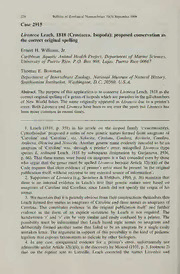
Case 2915. Lironeca Leach, 1818 (Crustacea, Isopoda): Proposed Conservation As The Correct Original Spelling PDF
Preview Case 2915. Lironeca Leach, 1818 (Crustacea, Isopoda): Proposed Conservation As The Correct Original Spelling
224 Bulletin ofZoological Nomenclature51(3)September 1994 Case 2915 Lironeca Leach, 1818 (Crustacea, Isopoda): proposed conservation as the correct original spelling Ernest H. Williams, Jr. Caribbean Aquatic Animal Health Project, Department ofMarine Sciences, University ofPuerto Rico, P.O. Box 908. Lajas, Puerto Rico 00667 Thomas E. Bowman Department ofInvertebrate Zoology, National Museum ofNatural History, Smithsonian Institution, Washington, D.C. 20560, U.S.A. Abstract. The purpose ofthis application is to conserve Lironeca Leach, 1818 as the correct originalspellingofagenusofisopodswhichareparasitesin thegillchambers ofNew World fishes. The name originally appeared as Livoneca due to a printer's error. Both Lironeca and Livoneca have been in use over the years but Lironeca has been more common in recent times. 1. Leach (1818, p. 351) in his article on the isopod family 'CYMOTHOADfe, Cymothoadae' proposed a series of new generic names formed from anagrams of 'Caroline' and 'Carolina', viz. Nelocira, Cirolana, Conilera, Rocinela, Canolira, Anilocra, Olencira and Nerocila. Another generic name evidently intended to be an anagram of 'Caroline' was, through a printer's error, misspelled Livoneca (type species L. rednianii Leach, 1818 by subsequent designation by Gurjanova, 1936, p. 66). That these names were based on anagrams is a fact conceded even by those who argue that the genus must be spelled Livoneca because Article 32(c)(ii) ofthe Code requires that clear evidence ofprinter's error must be present 'in the original publication itself, without recourse to any external source ofinformation'. 2. Supporters ofLivoneca (e.g. Sivertsen & Holthuis, 1980, p. 36) maintain that there is no internal evidence in Leach's text that generic names were based on anagrams of Caroline and Carolina, since Leach did not specify the origin of his names. 3. Wemaintainthatitispatentlyobviousfromtheirconstructionsthemselvesthat Leach formed five names as anagrams ofCaroline and three names as anagrams of Carolina. This constitutes evidence 'in the original publication itself and further evidence in the form of an explicit statement by Leach is not required. The handwritten 'r' and 'v' can be very similar and easily confused by a printer. The possibility must be infinitesimal that Leach based eight names on anagrams and deliberately formed another name that failed to be an anagram by a single easily mistaken letter. The argument in support of this possibility is the kind ofpedantic legalism that exposes taxonomists to ridicule by other biologists. 4. In any case, unequivocal evidence for a printer's error, unfortunately not admissible underArticle 32(c)(ii), is the discovery by Monod (1931, p. 5, footnote 2) that on the reprint sent to Latreille, Leach corrected the names Livonece and BulletinofZoologicalNomenclature51(3)September 1994 225 Livonecato Lironeceand Lironecaeverytimethat theyoccurred (eight times). There are other incorrect original spellings in Leach's paper: Recinele (latinized as Rocinela), Anilacre (elswhere spelt Anilocra). Desmaretii (for Desmarestii). 5. Wehavereviewedtheliteratureinourdatabase(Bowmanetal.,inpreparation) for the use ofthe Lironeca and Livoneca spellings in the last 50 years and over the period as a whole Lironeca predominates. The spelling Livoneca dominated from 1941 to 1960(27 vs. 7), the two spellingswereequally used from 1961 to 1970(17 vs. 18) but Lironecadominatesin themore recent(1971-1990) literature (104vs. 14)e.g. Williams & Bunkley-Williams, 1994; Bunkley-Williams & Williams, 1987; Bowman & Tareen, 1983. It would therefore be contrary to stability to 'revert' to Livoneca. 6. Although White (1847) was the first author to use the name Lironeca in print, heshouldnotbeconsideredtheauthorofthisname.White(1847,p. 109)gave Leach as the author ofthe genus Lironeca. 1. The subfamily name livonecinae Schioedte & Meinert, 1884 (p. 325) is therefore also based on an incorrect original spelling and we consider that it should be corrected to lironecinae Schioedte & Meinert, 1884 under Article 32c(iii) ofthe Code. 8. The International Commission on Zoological Nomenclature is accordingly asked: (1) to use its plenary powers to rule that Livoneca is an incorrect original spelling ofLironeca Leach, 1818; (2) to place on the Official List ofGeneric Names in Zoology the name Lironeca Leach, 1818(gender: feminine)(spelhngcorrectedin(1)above),typespeciesby subsequent designation by Gurjanova (1936) Livoneca redmanii Leach, 1818; (3) to place on the Official List ofSpecific Names in Zoology the name redmanii Leach, 1818,aspublishedinthebinomenLivoneca[sic]redmanii(specificname ofthe type species oiLironeca Leach, 1818); (4) to place on the Official List of Family-Group Names in Zoology the name LIRONECINAE Schioedte & Meinert, 1884 (type genus Lironeca Leach, 1818) (correction oflivonecinae); (5) to place on the Official Index of Rejected and Invalid Generic Names in Zoology the name Livoneca Leach, 1818 (ruled in (1) above to be an incorrect original spelling oiLironeca Leach, 1818); (6) toplaceon theOfficial IndexofRejectedand Invalid Family-GroupNamesin Zoology the name livonecinae Schioedte & Meinert. 1884 (an incorrect original spelhng oflironecinae Schioedte & Meinert, 1884). References Bowman, T.E. & Tareen, I.U. 1983. Cyraothoidae from fishes of Kuwait (Arabian Gulf) (Crustacea: Isopoda). Smithsonian Contrihulions to Zoology, 382: 1-30. Bowman,T.E., Bunkley-Williams, L.&Williams,E.H.Jr. 1995. (Inpreparation). Databaseof tlie cymollwidisopods. (Interactive Electronic Data Base). Bunkley-Williams, L. & Williams, E.H. Jr. 1987. Three new species of Renocila (Crustacea: Isopoda: Cymothoidae)externalparasitesofcoral reeffishesfrom theRyukyuIslandsof Japan. Proceedings ofthe BiologicalSociety ofWashington, 100: 417^32. Gurjanova, E.F. 1936. Isopodes des mers orientales. In Stackelberg, A.A. (Ed.), Fauna de lURSS,vol. 7,Crustacees,part 3. 278pp. L'AcademicdesSciencesdeI'URSS, U.S.S.R. [In Russian]. 226 Bulletin ofZoologicalNomenclature51(3)September 1994 Leach,VV.E. 1818. Cymothoadees.Cymothoadae(Crustacea). Pp. 338-354inCuvier, F.(Ed.), Diclionnairedessciencesnalurelle, vol. 12. 354 pp. Paris & Strasbourg. Monod,T. 1931. Surquelquescrustacesaquatiquesd'Afrique(CamerounetCongo). Revuede Zoologieel de BolaniqueAfricaines. 21(1): 1-36. Schioedte, J.C. & Meinert, F. 1884. Symbolaeet monographiam cymothoarumcrustaceorum isopodum familiae. IV: Cymothoidae. Naturhislorisk Tidsskriji, (3)14: 221^54. Sivertsen, E. & Holthuis, L.B. 1980. The marine isopod Crustacea ofthe Tristan da Cunha Archipelago. Gunneria, 35: 1-128. White,A. 1847. ListoflitespecimensofCrustaceainthecollectionsoftheBritishMuseum,viii, 143 pp. British Museum, London. Williams, E.H. Jr. & Bunkley-Williams, L. 1994. Ryukyua globosa n. gen., n. sp., and R. circulans n. comb., parasites in the opercular chambers of Pacific and Indian Ocean clupeid fishes. JournalofAquatic AnimalHealth. 6: 155-161.
